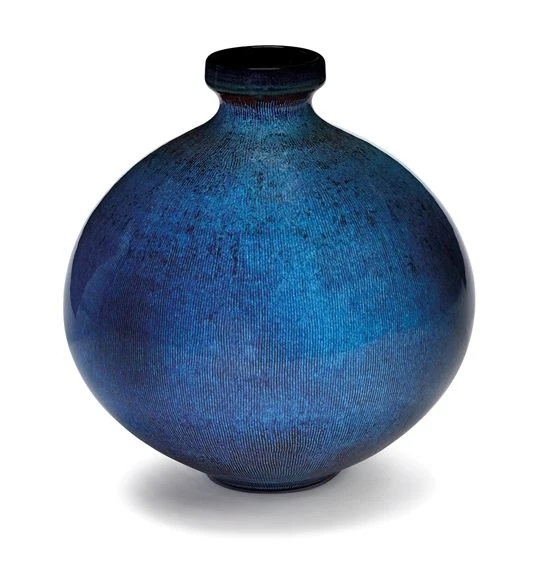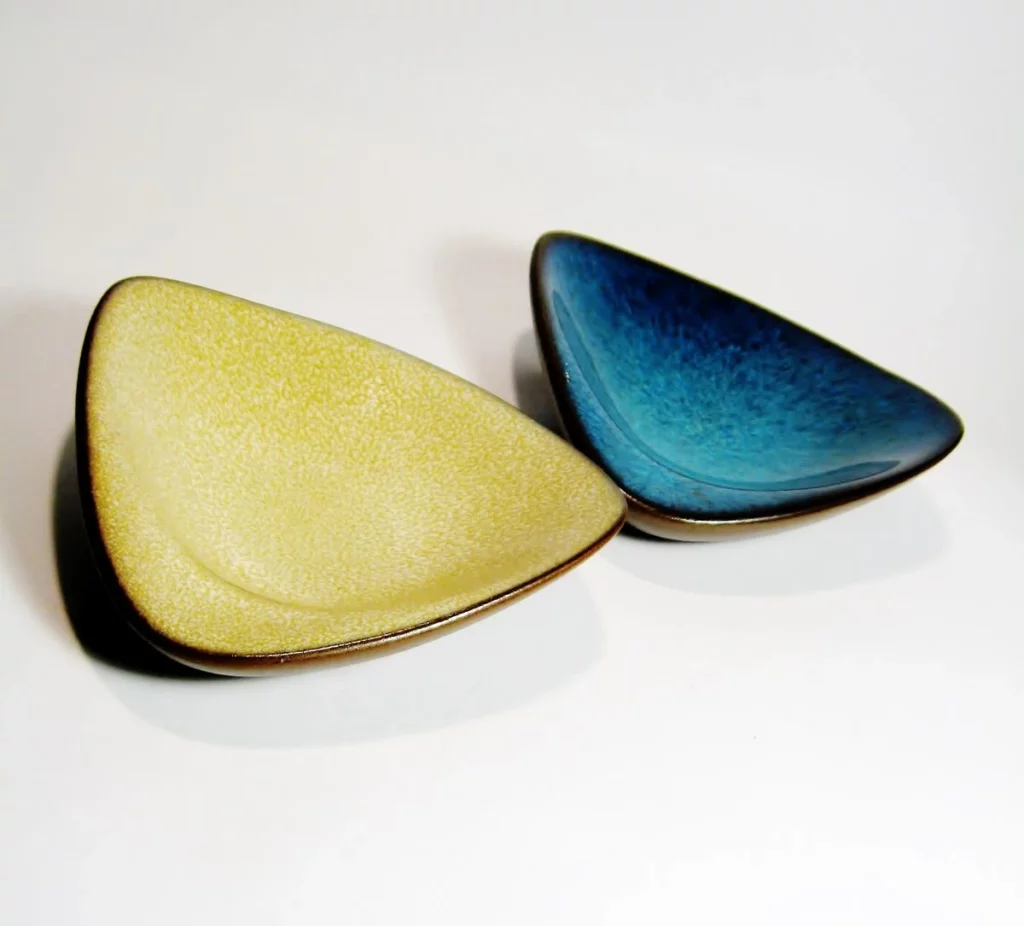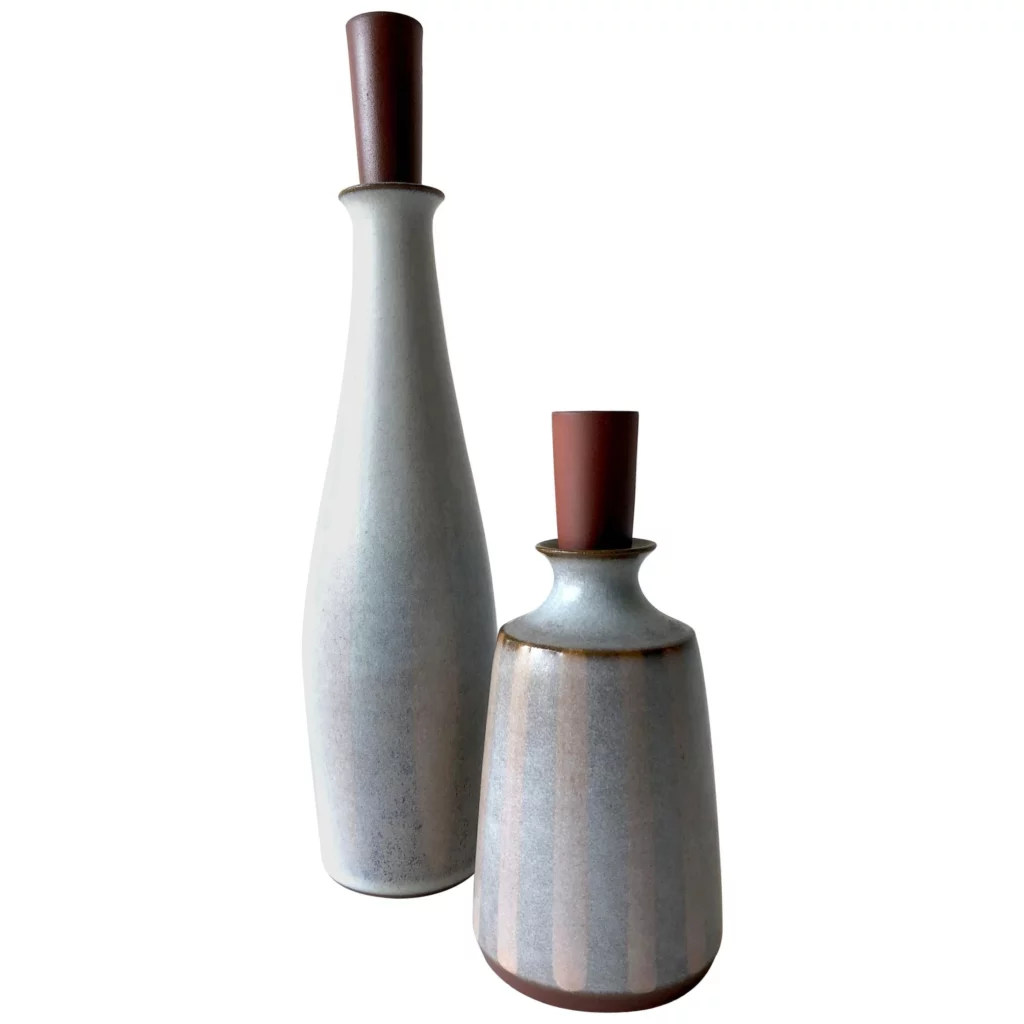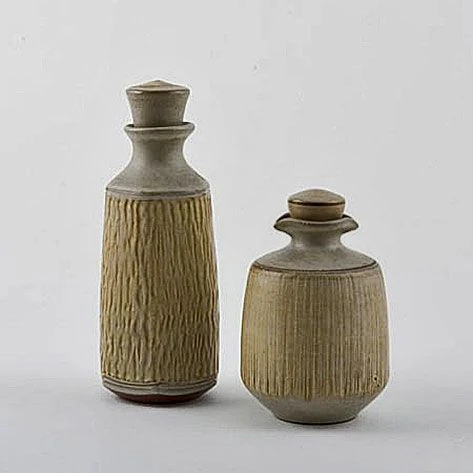Rupert Deese was an American ceramic artist. Rupert Deese is known for the innovative design and decoration of high-fired ceramics. Rupert J. Deese was born in Upland, California in 1952. He received his M.F.A. and B.A. degrees from the University of California at Santa Barbara. He was best known for creating functional decorative pottery with shapely forms and silky glazes.
Rupert Deese (born Rupert Julian Deese and known professionally as Rummy) was an American ceramic artist who lived from July 16, 1924, to July 12, 2010. He is well-known for his use of creative design and decorative techniques in high-fired ceramics.
“It is my aim in making these vessels that, as the perception of their beauty declines over time, they will be sustained by their delightful usefulness“
Rupert Deese
Artist Rupert Deese is well-known for his practical thrown forms made of cone 5 walnut colored stoneware and embellished with geometric repetition patterns on the exterior.
Deese frequently sprayed the glaze over his pots in order to achieve the surfaces he sought. In the early 1950s, he was one of the first production potters to publish a catalog in order to assist the sale of his work to department shops and other retail outlets.
Rupert Deese’s Career
Mr. Deese was born on the island of Guam, where his father served as a Marine Corps lieutenant during World War II. The Army Air Corps hired him as a B-17 mechanic after he graduated from high school in 1942.
He was stationed stateside throughout World War II. In 1950, Deese earned a Bachelor of Arts degree from Pomona College in the field of English.

Following college, he began working as a ceramist in Claremont, California, where he shared a studio with fellow ceramist Harrison McIntosh, among others. More than 60 years have passed since they started working together. He and Helen Smith (September 15, 1925 – June 4, 2010) were married in 1951 and raised four children. Deese Smith was born on September 15, 1925.

“Considering the pot shape as primary, I have generally used simple, geometric elements—stripes, circles, incised lines, and water-etched repeat patterns—to make the color and pattern of the finished piece”.
Rupert Deese

Deese attended Claremont Graduate School in the mid-1950s, thanks to a grant from local art benefactors Robert and Catherine Garrison. There, he studied ceramics with Richard Petterson and sculpture with Albert Stewart, and eventually graduated in 1959.
The community of artists in Claremont, including architects Millard Sheets and Jean and Arthur Ames, who provided encouragement and support in the early years of his career, as well as a close-knit circle of young artists, including woodworker Sam Maloof and painters Melvin Woods, Jim Hueter, Jim Fuller, and Karl Benjamin, also helped him along the way.
After getting his Master of Fine Arts in ceramics from the University of Michigan in 1957, Deese continued to work in his studio, creating his own ceramics. However, he discovered, like many other artists, that it was necessary to supplement his income. Following graduation, he began working as a ceramics instructor at Mt. San Antonio College in Walnut, California, where he remained until his retirement in 1971.
In 1958, Deese and McIntosh relocated their studio to a purpose-built facility close to McIntosh’s new home in Claremont’s Padua Hills neighborhood, where they remained until their deaths. His pottery first achieved national attention in 1960, when his covered bean jar took home the IBM sweepstakes prize at the Everson Museum in Syracuse, New York, as part of the prestigious 21st Ceramic National Exhibition.
A full-time post as a designer in the Franciscan Ceramics section of Interpace (International Pipe and Ceramics Corporation) in Los Angeles was available in 1964, and Deese took the position.
During his time as a consultant to the Franciscan Ceramics section, Millard Sheets put together a creative team of renowned artists that included ceramists Richard Petterson, Dora De Larios, Helen Richter Watson, Henry Takemoto, and Jerry Rothman, among others.
He continued to design shapes and patterns for Franciscan dinnerware, glassware, and flatware for the next twenty years, until his retirement in 1984. Deese was responsible for the creation of the Madeira dinnerware shapes, which is one of the company’s most popular dinnerware designs. Evenings and weekends were spent at his Padua Hills Claremont workshop, where he continued to create his own ceramics.
Rupert Deese’s Style

He designed shapes and patterns for Franciscan dinnerware, glassware, and flatware for the next twenty years, until his retirement in 1984. Deese was responsible for the creation of the Madeira dinnerware shapes, which is one of the company’s most popular dinnerware designs. Evenings and weekends were spent at his Padua Hills Claremont workshop, where he continued to create his own ceramics.
In spite of the fact that they are abstract, the works have a tangential relationship with scenery and watersheds around the upper Merced and Tuolumne Rivers in California, a location that the artist has come to adore and which has served as an inspiration for much of his artistic production.

Merced and Tuolumne Rivers is a series of twelve tondo-shaped painted structures created by Deese in 2002 to reflect this topography. The curved equal-area tiling pattern was produced to model this topography.
He divides the space of a circle into nine equal radial divisions, each of which has the same size. Subdividing these wedge forms into equal portions is accomplished by the use of additional radial lines and inscribed circles.
Each tile in a certain Array print has the same area as the other tiles in that print unless otherwise specified. The number of tiles in a specific print can range from as few as 18 to as many as 1152 depending on the design.
The colors of the prints are inspired by the landscape and sky of the Merced and Tuolumne counties. A variety of scales are represented by different colors: the purer red and green hues of the alpine flowers are represented by the purer reds, greens, yellows, and pinks; the grayed and tinted colors are represented by larger elements such as boulder groups and trees; and the blue shades and tints are represented by bodies of mountain water, an atmospheric perspective of horizons, and variable sky blues.
Dean Marshall, a La Jolla, California-based interior design firm, carried Deese’s hand-thrown ceramics in the 1950s, as did numerous other firms.
Tobey C. Moss Gallery in Los Angeles was where Deese’s ceramic pieces were sold in the 1970s, and in the 1990s, he had a gallery of his own in Claremont called Gallery 8. In addition to a drinking fountain for Oakmont Elementary School and personalized ashtrays for Harvey Mudd College benefactors, Deese designed a bronze tree for the Home Savings of America in Beverly Hills and a planter for the Members’ Dining Room of the United States Capitol. Many of these pieces were commissioned by Millard Sheets for clients of his Claremont design studio.
Museums, Exhibitions And Awards

- 1950-1956 Los Angeles County Fair Exhibition, Pomona, California
- 1950-57 Scripps College Art Museum, Claremont, California, Annual Ceramic Show
- 1951-52 Everson Museum, Syracuse, New York, Ceramic National Exhibition
- 1951-52 California State Fair, Sacramento, California
- 1954 Everson Museum, Syracuse, New York, Ceramic National Exhibition
- 1955-57 Pasadena Art Museum, Pasadena, California, California Designed Exhibition I, II, III
- 1956 Everson Museum, Syracuse, New York, Ceramic National Exhibition
- 1957 California State Fair, Sacramento, California
- 1960 Everson Museum, Syracuse, New York, 21st Ceramic National Exhibition
- 1965 Pasadena Art Museum, Pasadena, California, California Design 9
- 1995 Hillcrest Arts Festival, La Habra, California
- 1996 Tobey C. Moss Gallery, Los Angeles, Four Friends, The Work of Rupert Deese, Jim Hueter, Sam Maloof, and Harrison McIntosh
- 1996 Craft and Folk Art Museum Shop, Los Angeles
- 1997 The Chinati Foundation and The Judd Foundation, Marfa, Texas, Rupert Deese, Barnett Newman, and Dan Flavin
- 1998 Chaffey Community Art Association, Ontario, California
- 1999 Tobey C. Moss Gallery, Los Angeles, Stoneware
- 2000 Tobey C. Moss Gallery, Los Angeles, Rupert J. Deese (the Elder)Off the Wall, Rupert T. Deese (the Younger) On the Wall
- 2003 Tobey C. Moss Gallery, Los Angeles, Rupert Deese: Stoneware
- 2003 Cuttress Gallery, Pomona, California, Paul Soldner, John Blough, Rupert Deese, and Harrison McIntosh
- 2006 Tobey C. Moss Gallery, Los Angeles, California Modernism
- 2011 Compact Gallery, San Luis Obispo, California, Six Decades of Stoneware
- 2011 The Huntington Library, California, The House That Sam Built: Sam Maloof and Art in the Pomona Valley, 1945–1985
- 2011 Los Angeles County Museum of Art, California, California Design, 1930–1965: Living in a Modern Way
- 2011 American Museum of Ceramic Art, California, Common Ground: Ceramics in Southern California 1945–1975
- 1950-1951 Los Angeles County Fair Exhibition, Pomona, California. Honorable mention.
- 1951 Everson Museum, Syracuse, New York, Ceramic National Exhibition. Honorable mention.
- 1952 California State Fair. Second prize for a glaze.
- 1953 St. Paul Gallery, Fiber-Clay-Metal exhibition. Honorable mention and purchase award.
- 1960 Everson Museum, Syracuse, New York, 21st Ceramic National Exhibition. IBM sweepstakes prize.
Other Collections

- Museum of Fine Arts, Boston, Boston
- Everson Museum, Syracuse, New York
- Henry Art Gallery, University of Washington, Seattle
- Long Beach Museum of Art, Long Beach, California
- Los Angeles County Museum of Art, Los Angeles
- Maloof Foundation, Alta Loma, California
- Millard Sheets Collection, Gualala, California
- Mingei International Museum, San Diego
- Nora Eccles Harrison Museum of Art, Logan, Utah
- Renwick Gallery, Smithsonian Institution, Washington, DC
- Richard & Alice Petterson Museum, Claremont, California
- Roger Corsaw Collection, Alfred University, Alfred, New York
- Scripps College, Claremont, California
- St. Paul Gallery, Minneapolis
- Walker Art Center, Minneapolis
- American Museum of Ceramic Art, Pomona, California
Images pinterest = Rupert Deese





